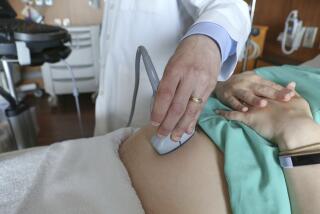Counting on MDs to Relieve the Pain
- Share via
Michael Criley suddenly awoke from sleep in agony. His wife found him “flopping like a fish” on the floor next to their bed.
Criley, a Los Angeles cardiologist, phoned a kidney specialist who was also a close friend. The specialist rushed over to the house and quickly diagnosed Criley as having a kidney stone, an excruciatingly painful condition also called renal colic. Throwing a mattress into his station wagon, the specialist loaded Criley into his car and transported him, still flopping, to the hospital emergency room.
“I was out of my gourd,” says Criley, recalling the incident of more than 20 years ago. “Except for one beady-eyed thought. If I didn’t get 75 milligrams of Demerol [an injectable narcotic painkiller] within five minutes, I was going to tear that ER down.” Minutes after getting the drug, Criley felt so much better that he spent the next few hours catching up on paperwork.
Three years later, it was a different story when a bout of colic put Criley back in the ER. Wearing rumpled clothes and nearly speechless from pain, he again asked for Demerol. But the resident on duty (who didn’t know his patient, although Criley worked at the same hospital) prescribed oral codeine, a much less potent remedy. Since local pharmacies were already closed, hours passed before Criley could fill his prescription at the nearest all-night drug store.
After that episode, Criley stashed pain pills at home, in his car and in his medical bag, vowing never again to live through another kidney stone without pain relief at hand.
There was a time when relieving pain and suffering was a doctor’s sacred mission. In many cases it was also his sole mission, since he could offer little else. Why, then, do modern doctors, with their vast trove of drugs and technology, sometimes balk at treating pain?
One reason is that doctors are suspicious of drug-seeking behavior. Strange as it sounds, during his second kidney attack, even Michael Criley may have fallen under this cloud. At least that’s what he suspects, having shown up at his own ER disheveled and near-incoherent, just the outward appearance to prompt a physician’s inner query: Is this patient an addict, a con man or the real thing? No one likes being hoodwinked, especially docs who think their deceiver is a drug user.
*
Another reason is that generations of doctors, mine included, have had this adage hammered into our heads: Pain is a diagnostic clue. Back then, the teaching had logic. Why? Because prior to CT scans, ultrasounds and other modern diagnostic tools, surgeons often watched pain before committing patients to the knife.
In the early 1970s, for example, when I was in medical school residing in a dormitory, a law student down the hall spent hours in still, breathless agony while a general surgeon waited for her belly pain to localize, thus confirming appendicitis. Right-sided tenderness, when it finally surfaced, was her ticket to the operating room.
A final reason: lack of empathy. This is hard for patients to swallow. Many front-line doctors haven’t a clue what real pain is, too young or too lucky to have yet experienced their first kidney stone, migraine headache or pinched nerve from a slipped lumbo-sacral disc.
After all, pain rarely kills. It only leaves a sick, lingering memory but no visible scars. Now add an anonymous doctor-patient relationship (along the lines of Criley’s second ER encounter) and medical accountability and compassion sometimes fly out the window.
*
Fortunately, most doctors are not sadists, and time and custom are finally catching up with the problem of pain. Recently, a family member suffered the groaning, doubled-over woes of renal colic, and his ER treatment was prompt and effective. Within 60 seconds of arrival, a nurse asked him to grade his pain on a scale of 1 to 10--a protocol now mandated by the nation’s largest hospital-accrediting organization. Today, conferences, journal articles and hospital bulletin boards also remind us that pain is the “fifth vital sign,” a quantifiable symptom just as important as blood pressure, pulse, temperature and breathing rate.
Pain does have its purpose. In most cases, it’s an early warning system designed to preserve life, not to destroy it. But pain can destroy spirit and hope. Relieving and managing pain is still one of doctoring’s highest arts. It always will be. Just ask Michael Criley.
Wanted: Some Good Stories for the Files
Health is seeking submissions from physicians for its Doctor Files column, a monthly feature that explores the art of medicine. The column seeks to illuminate the human aspect of medicine, including the doctor-patient relationship, and to explore topics that can help readers better understand how medicine is changing today. Submissions, which should be 700 to 800 words in length, can be sent by e-mail to [email protected], or by regular mail to Doctor Files, Health, Los Angeles Times, 202 W. 1st St., Los Angeles, CA 90012. Include daytime and evening phone numbers. Submissions cannot be returned.
*
Claire Panosian Dunavan is an infectious-diseases specialist practicing at UCLA Medical Center. She can be reached at [email protected] The Doctor Files runs the fourth Monday of every month in Health.
More to Read
Sign up for Essential California
The most important California stories and recommendations in your inbox every morning.
You may occasionally receive promotional content from the Los Angeles Times.










